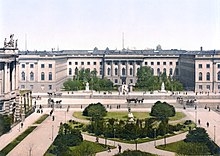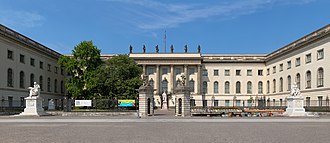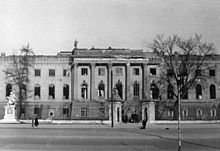Prince Heinrich's palace
The palace of Prince Henry (also Prince Heinrich Palace ) on the boulevard Unter den Linden 6 in Berlin's district of Mitte is a former palace of the Hohenzollern and part of the Forum Fridericianum . Built for the Prussian Prince Heinrich in the years 1748–1753 by Johann Boumann in the Baroque style , in 1809 it was rededicated as a university building. In World War II burned out, it was outside faithfully until 1962 and inside easier as the main building of the Humboldt University rebuilt.
Eight loan sculptures from the Potsdam City Palace have stood on the side wings of the monument since 1967 , and their return in connection with the reconstruction as a state parliament building has been discussed again and again.
history

The Prussian King Friedrich II had the building erected for his brother Prince Heinrich between 1748 and 1753 . The plans for the late baroque building came from Johann Boumann , who is said to have based himself on the first drafts by Georg Wenzeslaus von Knobelsdorff .
Knobelsdorff was originally supposed to build a residence for Friedrich II at this point, as part of a larger building ensemble, the so-called Forum Fridericianum . After the Margraves of Brandenburg-Schwedt refused to sell their existing palace, the predecessor of the Old Palace , for the new construction of the planned large forum, Friedrich II moved away from the idea of the Palais du Roy and settled in an apartment in the Berlin City Palace refurbish and concentrate its construction activities on Potsdam. However, since the Royal Court Opera opposite was already built according to Knobelsdorff's plans on the empty strip of land of the former fortifications and needed a frame, Friedrich II. As the builder again provided sketches of ideas. This is how the palace, which was remarkably spacious for a young prince, who was still unmarried at the time, was built on the site originally intended for the royal palace. At the same time the Hedwig Church was built opposite , only consecrated in 1773, and the Royal Library from 1775–1786 , so that a greatly reduced version of the forum was finally completed.
The facade design was based on the shapes of the opera house and was obviously aimed at giving the square a uniform design. Construction management was first carried out by Boumann himself, later by Carl Ludwig Hildebrandt , when Boumann was given responsibility for the entire Berlin construction industry in 1755. By this time the costs for the Prinz-Heinrich-Palais had already risen to 200,000 thalers, in 1756 another 33,000 thalers were approved - enormous sums at the time for a project of this kind. Work here was slow and stopped altogether during the Seven Years' War . It was not until the beginning of 1766 that the prince could move in with his court , together with his wife Wilhelmine von Hessen-Kassel , with whom he had been married in 1752 for reasons of state. Heinrich lived in the building until his death in 1802, unless he stayed at his Rheinsberg Castle or in his apartment in the Potsdam City Palace , and Wilhelmine lived in the building until her death in 1808, albeit in separate apartments in the two side wings.
When the Berlin University was founded in 1809, the Prussian King Friedrich Wilhelm III dedicated it . the building. In the years 1836 to 1846 and 1892 the interior of the palace was adapted to the requirements of the university. Between 1913 and 1920, the Berlin city planning officer Ludwig Hoffmann extended the building by extending the two side wings while maintaining the architectural style and the eaves height towards the north and adding side extensions. The U-shape became today's H-shape.
During the Second World War , large parts of the building were destroyed, mainly during the bombing raids between November 24, 1943 and July 19, 1944. Teaching was resumed in 1945 in some provisionally repaired rooms in the west wing. Then the building was in two phases based on historical models rebuilt : from 1947 to 1954 the central section, 1958-1962 the east wing, today where the auditorium is located. Only a few parts of the building, such as a staircase in the eastern end of the building, have been preserved in the original. The building has been a listed building since 1975.
The palace will be renovated inside and out by 2020 for 43 million euros.
Attic sculptures
The attic sculptures created around 1753 by the sculptor Johann Gottlieb Heymüller are related to the use of the palace, the life of Prince Heinrich and his wife, and Ovid's metamorphoses . On the middle risalit are the pairs of sculptures Jason and Medea , Peleus and Thetis as well as Atalante and Meleager . They were destroyed in World War II and replaced by reconstructions by the sculptor Albert Braun when the Humboldt University was rebuilt in 1953 . On the eastern side elevation were the pairs of sculptures Adonis and Venus as well as Perseus and Andromeda , on the western side Bacchus and Ariadne as well as Mercury and Herse . They were destroyed in World War II and replaced in 1967 by loan sculptures from the Potsdam City Palace .
Since it was rebuilt as a state parliament building , the Potsdam Palace Association has demanded the return of the loaned sculptures in accordance with Article 8 of the Venice Charter . He refers to their poor condition, their wrong size and their lack of coherence in the palace of Prince Heinrich and criticizes their current display as " looted art ". In addition to the Schlossverein, the local citizens' initiative Mitteschön, the Berlin historian Annette Ahme, Brandenburg's CDU general secretary Steeven Bretz , Berlin's CDU cultural expert Uwe Lehmann-Brauns , the lawyer Erardo Rautenberg and the publicist Lea Rosh support the return of the loaned sculptures. However, the Humboldt University of Berlin, the Berlin State Monument Council and the Prussian Palaces and Gardens Foundation Berlin-Brandenburg have so far rejected this with reference to the existing monument protection.
literature
- Klaus-Dietrich Gandert: From the Prinzenpalais to the Humboldt University . Berlin 2004.
Web links
- Entry in the Berlin State Monument List with further information
- Destruction of World War II: main building of the university
- The parapet sculptures - Humboldt University Berlin
- 57th Session City Forum Potsdam: “City Palace Figures - Status of the Debate and Further Approach” - State Capital Potsdam
Individual evidence
- ↑ https://www.hu-berlin.de/de/pr/medien/publikationen/humboldt/2015/201306/humboldt-ausgabe-9-2014-15
- ↑ hu-presse: A staging of beauty and power - press portal. Retrieved October 6, 2018 .
- ↑ “Works of sculpture, painting or decorative equipment that are an integral part of a monument must not be separated from it; unless this measure is the only way to ensure their preservation. ” Article 8 of the Venice Charter
- ↑ New building of the Landtag with gaps: Hercules is coming in autumn. Retrieved July 13, 2019 .
- ↑ Mitteschön demands return of the attic figures. Retrieved September 28, 2018 .
- ↑ Lea Rosh: City Palace Figures to Potsdam. Retrieved September 28, 2018 (German).
- ↑ Hardened fronts. Retrieved September 28, 2018 .
Coordinates: 52 ° 31 '5 " N , 13 ° 23' 36" E




